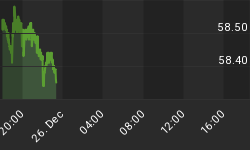The Federal Reserve Open Market Committee (FOMC) concluded a two-day meeting by initiating "Operation Twist." The FOMC's press release explained: "The Committee intends to purchase, by the end of June 2012, $400 billion of Treasury securities with remaining maturities of 6 years to 30 years and to sell an equal amount of Treasury securities with remaining maturities of 3 years or less. This program should put downward pressure on longer-term interest rates and help make broader financial conditions more accommodative."
This announcement initiated sell programs in almost every market. There are many reasons for this reaction, one of which was the recognition that every initiative has failed, and now, all they can think to do is drive down yields that are already below 2.00%!
A reason for the Fed's failure is the array of topics that never enter the mind of economists such as Federal Reserve Chairman Ben S. Bernanke. These include money, credit, debt, and capital.
The productivity of capital is an important consideration, one which most people understand, in their own words. A bank does not lend money to a business that can not earn its way to paying back the loan. A potential borrower understands the banker's hurdle. (This refers to the majority of smaller banks in the country where the officers lose their jobs or worse when the bank fails if it adopts such a strategy.) An investor buys shares of common stock in a company that will produce the most from the least. The higher the profits produced per share, the more the shares should be worth.
Ben & friends do not think this way. During the Fed's quantitative easing schemes, the additional debt has produced nothing. The Federal Reserve, including the Board, the FOMC, and the thousands of Ph.D. researchers may not know even know of this relationship, but there is a growing understanding, intuitive or quantitative, that sees the Bernanke Fed as failing by a greater degree with every new initiative.
During the 1980s, the change (rise) in non-financial domestic debt divided by the change (rise) in nominal Gross Domestic Product was 2.2. That is, for every $2.20 borrowed, the United States produced $1.00 of additional goods and services (nominal). In the 1990s, debt was less efficient. It took extra debt to accomplish the same. The ratio (rise in debt-to-GDP) was 2.7:1. Between 2001 and 2008, even more debt was needed to produce more stuff: the ratio rose to 4.2:1.
The Fed has been rolling out its various quantitative initiatives since early 2009. The ratio of debt to production has been 3.7:1 (through June, 2011). But, the increase in transfer payments (1-in-7 Americans now receive food stamps, Cash for Clunkers, shovel-ready bank bailouts) exceeds the rise in nominal GDP by a wide margin. As a measure of financial efficiency, the ratio is now meaningless.
The additional debt being manufactured is not producing any additional goods and services. The more Bernanke applies his senior thesis to the real economy, the less the economy is able to pay down old debt, much less manufacture additional goods and services to pay down the new debt.
The Fed has pegged short-term interest rates at zero; Operation Twist is an attempt to drive long-term rates to zero (or, close to it); the rise of incomes in the United States since 2008 has been zero; "real" GDP growth since QE1 has been less than zero; the FOMC is an absolute zero.
Somebody in the past couple of weeks, I forget who (my apologies), compared the central bankers' Mad Hatter policies to the strange physical transformations when approaching absolute zero (-273 Celsius). Solids, liquids, and gases behave strangely.
We have arrived at that point with financial markets. The Authorities have lost control of the markets they have been manipulating. Desperate tactics, with untold unintended consequences, such as the Swiss National Bank doubling its monetary base last month, ensure more fanatical outbursts from the Fed, the ECB, and the Bank of Japan. In this setting, gold fell more than $150 last week. Other than remote islands, this is the best bargain around.
Frederick Sheehan writes a blog at www.aucontrarian.com
















